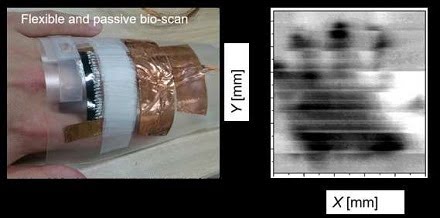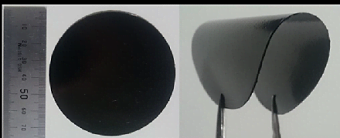TOKYO, Nov. 28, 2016 — Most terahertz imaging systems are very bulky — think body scanners at airports that rotate 360 degrees. But a new portable and wearable terahertz scanning device using arrays of carbon nanotubes (CNT) could make it easier to perform noninvasive inspections — everything from medical and drug delivery equipment inspections to imaging of cancer cells, blood clots, sweat glands and teeth.

Terahertz image of a hand using arrays of carbon nanotubes. Courtesy of Tokyo Institute of Technology.
A team of scientists from the Tokyo Institute of Technology’s Laboratory for Future Interdisciplinary Research of Science and Technology made a breakthrough in developing a flexible terahertz scanner by integrating 23 CNTs onto a single array. CNTs have previously been used for the fabrication of photodetectors that operate in the visible, infrared and terahertz regions of the electromagnetic spectrum.

An inch-sized CNT film. The mechanical strength of the film endows it with high flexibility. Courtesy of Tokyo Institute of Technology.
Scientist Yukio Kawano told Photonics Media the 23-element array is a significant achievement and the first CNT-based terahertz scanner of its kind.
“The CNT film was cut into smaller pieces using a pair of scissors so that the dimensions of each piece were adapted to the device size for a multi-element scanner,” said Kawano. “Each detector element was formed on this CNT film through electrode metal evaporation.”
Cutting the film and using electrode metal evaporation actually increased the mechanical strength of the film and its flexibility, enabling it to be readily bent over a wide range of angles. This element has been missing from past prototypes and allows the portable device to image and reproduce the curved contours of 3D objects. CNT films also absorb electromagnetic resonance over a broad terahertz range, eliminating the need for planar antennas to scan objects.
With the novel terahertz scanner, Kawano and his team have successfully imaged flat and curved samples, and performed multi-view scans of cylindrical samples. They have also performed passible wearable imaging of a hand. Kawano said this is just the beginning as they plan to develop a larger element array for high-resolution imaging.

Objects scanned using the novel portable and wearable terahertz scanning device. Courtesy of Yukio Kawano/Tokyo Institute of Technology.
“We are applying our technology to high-speed and multi-view inspections of industrial products, especially non-flat samples such as PET bottles, syringes, foods and pharmaceutical products,” he said. “We also plan to apply this technology to medical examinations for real-time monitoring of daily health conditions.”
Without using complex optics or equipment, the Tokyo Tech team has created a portable, wearable, flexible terahertz scanner they hope will soon challenge the conventional bulky peripheral optical components presently used.
The research was published in Nature Photonics (doi: 10.1038/nphoton.2016.209).